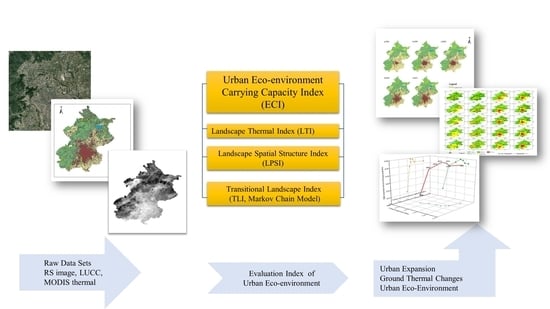Coupling Analysis of the Thermal Landscape and Environmental Carrying Capacity of Urban Expansion in Beijing (China) over the Past 35 Years
Abstract
1. Introduction
2. Materials and Methods
2.1. Data Source and Preprocessing
2.2. Quantitative Evaluation Indices
3. Environmental Setting
4. Results
4.1. Urban Expansion during the Past Four Decades, 1984–2018
4.2. Urban Thermal Landscape Dynamics in the Process of Urban Expansion
4.3. Coupling Analysis of Urbanization, Thermal Landscape and Environment Carrying Capacity
5. Conclusions and Discussion
Author Contributions
Funding
Institutional Review Board Statement
Informed Consent Statement
Data Availability Statement
Acknowledgments
Conflicts of Interest
References
- Andreasen, M.H.; Agergaard, J.; Kiunsi, R.B.; Namangaya, A.H. Urban transformations, migration, and residential mobility patterns in African secondary cities. Geogr. Tidsskr. J. Geogr. 2017, 117, 93–104. [Google Scholar] [CrossRef]
- Chen, M.; Lu, D.; Zhang, H. Comprehensive evaluation, and the driving factors of China’s urbanization. Acta Geogr. Sin. 2009, 64, 387–398. (In Chinese) [Google Scholar]
- Bloom, D.; Canning, D.; Fink, G. Urbanization and the Wealth of Nations. Science 2008, 319, 772–775. [Google Scholar] [CrossRef]
- Kojima, R. Introdution: Population Migration and Urbanization in Developing Countries. Dev. Econ. 1996, 34, 349–369. [Google Scholar] [CrossRef] [PubMed]
- NBSC National Data. National Bureau of Statistics of China. 2018. Available online: http://www.stats.gov.cn/tjsj/ndsj/2018/indexeh.htm (accessed on 14 October 2020).
- Li, G.; Li, F. Urban sprawl in China: Differences and socioeconomic drivers. Sci. Total Environ. 2019, 673, 367–377. [Google Scholar] [CrossRef]
- Liu, J.; Shen, Z.; Chen, L. Assessing how spatial variations of land use pattern affect water quality across a typical urbanized watershed in Beijing, China. Landsc. Urban Plan. 2018, 176, 51–63. [Google Scholar] [CrossRef]
- Lovell, S.T.; Johnston, D.M. Creating multifunctional landscapes: How can the field of ecology inform the design of the landscape? Front. Ecol. Environ. 2009, 7, 212–220. [Google Scholar] [CrossRef]
- Termorshuizen, J.W.; Opdam, P.; Brink, A.V.D. Incorporating ecological sustainability into landscape planning. Landsc. Urban Plan. 2007, 79, 374–384. [Google Scholar] [CrossRef]
- Makhzoumi, J.M. Landscape ecology as a foundation for landscape architecture: Application in Malta. Landsc. Urban Plan. 2000, 50, 167–177. [Google Scholar] [CrossRef]
- Owen, T.W.; Carlson, T.N.; Gillies, R.R. An assessment of satellite remotely sensed land cover parameters in quantitatively describing the climatic effect of urbanization. Int. J. Remote Sens. 1998, 19, 1663–1681. [Google Scholar] [CrossRef]
- Sun, R.; Chen, A.; Li, F.; Wang, D.; Xu, Z.; Chen, L. Guidelines, and evaluation indicators of urban ecological landscape construction. Acta Ecol. Sin. 2013, 33, 2322–2329. (In Chinese) [Google Scholar]
- Chiesura, A. The role of urban parks for the sustainable city. Landsc. Urban Plan. 2004, 68, 129–138. [Google Scholar] [CrossRef]
- Khosla, R.; Bhardwaj, A. Urbanization in the time of climate change: Examining the response of Indian cities. Wiley Interdiscip. Rev. Clim. Chang. 2019, 10, e560. [Google Scholar] [CrossRef]
- Kerbler, B. Population ageing and urban space. Annales-Anali Istrske Mediter. Stud. Ser. Histor. Sociol. 2015, 25, 33–48. [Google Scholar]
- Grimm, N.B.; Faeth, S.H.; Golubiewski, N.E.; Redman, C.L.; Wu, J.; Bai, X.; Briggs, J.M. Global Change and the Ecology of Cities. Science 2008, 319, 756–760. [Google Scholar] [CrossRef] [PubMed]
- Foley, J.A.; de Fries, R.; Asner, G.P.; Barford, C.; Bonan, G.; Carpenter, S.R.; Chapin, F.S.; Coe, M.T.; Daily, G.C.; Gibbs, H.K.; et al. Global Consequences of Land Use. Science 2005, 309, 570–574. [Google Scholar] [CrossRef] [PubMed]
- Arnfield, A.J. Two decades of urban climate research: A review of turbulence, exchanges of energy and water, and the urban heat island. Int. J. Clim. 2003, 23, 1–26. [Google Scholar] [CrossRef]
- Vlahov, D. Urbanization, Urbanicity, and Health. J. Hered. 2002, 79, S1–S12. [Google Scholar] [CrossRef]
- Ndetto, E.L.; Matzarakis, A. Urban atmospheric environment and human biometeorological studies in Dar es Salaam, Tanzania. Air Qual. Atmos. Heal. 2014, 8, 175–191. [Google Scholar] [CrossRef]
- Maranghi, S.; Parisi, M.L.; Facchini, A.; Rubino, A.; Kordas, O.; Basosi, R. Integrating urban metabolism and life cycle assessment to analyse urban sustainability. Ecol. Indic. 2020, 112, 106074. [Google Scholar] [CrossRef]
- Newcombe, K.; Ambio, A.J. The metabolism of a city: The case of Hong Kong. Ambio 1978, 7, 3–15. [Google Scholar]
- Chen, Y.; Yu, S. Impacts of urban landscape patterns on urban thermal variations in Guangzhou, China. Int. J. Appl. Earth Obs. Geoinform. 2017, 54, 65–71. [Google Scholar] [CrossRef]
- Xu, S.; Li, F.; Zhang, L.; Zhou, L. Spatiotemporal changes of thermal environment landscape pattern in Changsha. Acta Ecol. Sin. 2015, 35, 3743–3754. (In Chinese) [Google Scholar]
- Zhu, S.; Zhang, G.; Liu, Y. Change of underlying surface pattern and its local thermal environment effect in Suzhou city. Sci. Geogr. Sin. 2012, 32, 859–865. (In Chinese) [Google Scholar]
- Liu, J.; Yang, Z. Dynamicss of temperature and humidity in underlaying surface of different landscape type in winter in Beijing city, China. Acta Ecol. Sin. 2009, 29, 3241–3252. (In Chinese) [Google Scholar]
- Li, W.; Ouyang, Z.; Wang, R.; Wang, X. Landscape pattern and their formation of urban ecosystems. Chin. J. Ecol. 2005, 24, 428–432. (In Chinese) [Google Scholar]
- Wang, R.; Li, F.; Hu, D.; Li, B.L. Understanding eco-complexity: Social-Economic-Natural Complex Ecosystem approach. Ecol. Complex. 2011, 8, 15–29. [Google Scholar] [CrossRef]
- Alberti, M. The Effects of Urban Patterns on Ecosystem Function. Int. Reg. Sci. Rev. 2005, 28, 168–192. [Google Scholar] [CrossRef]
- Wang, Y.; Zhan, Q.; Ouyang, W. Impact of Urban Climate Landscape Patterns on Land Surface Temperature in Wuhan, China. Sustainability 2017, 9, 1700. [Google Scholar] [CrossRef]
- Chen, L.; Sun, R.; Liu, H. Eco-environmental effects of urban landscape pattern changes: Progresses, problems, and perspectives. Acta Ecol. Sin. 2013, 33, 1042–1050. (in Chinese). [Google Scholar] [CrossRef]
- Tv, R.; Aithal, B.H.; Sanna, D.D. Insights to urban dynamics through landscape spatial pattern analysis. Int. J. Appl. Earth Obs. Geoinform. 2012, 18, 329–343. [Google Scholar] [CrossRef]
- Gergel, S.E.; Turner, M.G.; Miller, J.R.; Melack, J.M.; Stanley, E.H. Landscape indicators of human impacts to riverine systems. Aquat. Sci. 2002, 64, 118–128. [Google Scholar] [CrossRef]
- Liu, P.; Wu, C.; Chen, M.; Ye, X.; Peng, Y.; Li, S. A Spatiotemporal Analysis of the Effects of Urbanization’s Socio-Economic Factors on Landscape Patterns Considering Operational Scales. Sustainability 2020, 12, 2543. [Google Scholar] [CrossRef]
- Yao, Y. Essential Geography Landscapes and Ecological Culture in Nanjing. Acta Geogr. Sin. 2009, 64, 677–686. (In Chinese) [Google Scholar]
- Peng, J.; Wang, Y.; Jing, J.; Song, Z.; Han, D. Research on integrated regional planning of urban landscape functions: A case study in Shenzhen City. Acta Ecol. Sin. 2005, 25, 1714–1719. (In Chinese) [Google Scholar]
- López, E.; Verdinelli, G.B.; Mendoza, M.; Duhau, E. Predicting land-cover and land-use change in the urban fringe. Landsc. Urban Plan. 2001, 55, 271–285. [Google Scholar] [CrossRef]
- Bai, Y.; Deng, X.; Jiang, S.; Zhang, Q.; Wang, Z. Exploring the relationship between urbanization and urban eco-efficiency: Evidence from prefecture-level cities in China. J. Clean. Prod. 2018, 195, 1487–1496. [Google Scholar] [CrossRef]
- Wu, J.; Xiang, W.-N.; Zhao, J. Urban ecology in China: Historical developments and future directions. Landsc. Urban Plan. 2014, 125, 222–233. [Google Scholar] [CrossRef]
- Wu, P.; Tan, M. Challenges for sustainable urbanization: A case study of water shortage and water environment changes in Shandong, China. Proc. Environ. Sci. 2012, 13, 919–927. [Google Scholar] [CrossRef]
- la Point, S.; Balkenhol, N.; Hale, J.; Sadler, J.P.; van der Ree, R. Ecological connectivity research in urban areas. Funct. Ecol. 2015, 29, 868–878. [Google Scholar] [CrossRef]
- Yeh, C.-T.; Huang, S.-L. Investigating spatiotemporal patterns of landscape diversity in response to urbanization. Landsc. Urban Plan. 2009, 93, 151–162. [Google Scholar] [CrossRef]
- Luck, M.; Wu, J. A gradient analysis of urban landscape pattern: A case study from the Phoenix metropolitan region, Arizona, USA. Landsc. Ecol. 2002, 17, 327–339. [Google Scholar] [CrossRef]
- Hu, D.; Meng, Q.; Zhang, L.; Zhang, Y. Spatial quantitative analysis of the potential driving factors of land surface temperature in different “Centers” of polycentric cities: A case study in Tianjin, China. Sci. Total Environ. 2020, 706, 135244. [Google Scholar] [CrossRef] [PubMed]
- Yang, J.; Li, S.; Lu, H. Quantitative Influence of Land-Use Changes and Urban Expansion Intensity on Landscape Pattern in Qingdao, China: Implications for Urban Sustainability. Sustainability 2019, 11, 6174. [Google Scholar] [CrossRef]
- Guo, L.; Xia, B.; Liu, W.; Jiang, X. [Spatio-temporal change and gradient differentiation of landscape pattern in Guangzhou City during its urbanization]. Ying Yong Sheng Tai Xue Bao J. Appl. Ecol. 2006, 17, 1671–1676. [Google Scholar]
- Wang, Z. Evolving landscape-urbanization relationships in contemporary China. Landsc. Urban Plan. 2018, 171, 30–41. [Google Scholar] [CrossRef]
- Weng, Y.-C. Spatiotemporal changes of landscape pattern in response to urbanization. Landsc. Urban Plan. 2007, 81, 341–353. [Google Scholar] [CrossRef]
- Jaeger, J.A. Landscape division, splitting index, and effective mesh size: New measures of landscape fragmentation. Landsc. Ecol. 2000, 15, 115–130. [Google Scholar] [CrossRef]
- Yue, W.; Xu, L. Thermal environment effect of urban land use type and patterna case study of central area of Shanghai city. Sci. Geogr. Sin. 2007, 27, 243–248. (In Chinese) [Google Scholar]
- Chen, Y.; Shi, P.; Li, X.; He, C. Research on urban spatial thermal envnrionmental using remote sensing image -fractal measurement of thermal field structure and its change. Acta Geod. Cartogr. Sin. 2002, 31, 322–326. (In Chinese) [Google Scholar]
- del Monte-Luna, P.; Brook, B.W.; Zetina-Rejón, M.J.; Cruz-Escalona, V.H. The carrying capacity of ecosystems. Glob. Ecol. BioGeogr. 2004, 13, 485–495. [Google Scholar] [CrossRef]
- Saaty, T.L. A scaling method for priorities in hierarchical structures. J. Math. Psychol. 1977, 15, 234–281. [Google Scholar] [CrossRef]
- Saaty, T.L.; Vargas, L.G. Hierarchical analysis of behavior in competition: Prediction in chess. Syst. Res. Behav. Sci. 1980, 25, 180–191. [Google Scholar] [CrossRef]
- Wang, J.; Jing, Y.-Y.; Zhang, C.-F.; Zhao, J.-H. Review on multi-criteria decision analysis aid in sustainable energy decision-making. Renew. Sustain. Energy Rev. 2009, 13, 2263–2278. [Google Scholar] [CrossRef]
- Arsanjani, J.J.; Helbich, M.; Kainz, W.; Boloorani, A.D. Integration of logistic regression, Markov chain and cellular automata models to simulate urban expansion. Int. J. Appl. Earth Obs. Geoinform. 2013, 21, 265–275. [Google Scholar] [CrossRef]
- Muller, M.R.; Middleton, J. A markov model of land-use change dynamics in the niagara region, ontario, canada. Landsc. Ecol. 1994, 9, 151–157. [Google Scholar]
- NBSC National Data. National Bureau of Statistics of China. 2019. Available online: http://www.stats.gov.cn/tjsj/ndsj/2019/indexeh.htm (accessed on 14 October 2020).
- Wenhui, K.; Jiyuan, L.I.U.; Quanqin, S.; Chaoyang, S.U.N. Spatio-temporal patterns and driving forces of urban expansion in Beijing central city since 1932. Geo-Inf. Sci. 2009, 11, 428–435. (In Chinese) [Google Scholar]
- Fei, W.; Zhao, S. Urban land expansion in China’s six megacities from 1978 to 2015. Sci. Total Environ. 2019, 664, 60–71. [Google Scholar] [CrossRef]
- Fang, C.; Zhao, S. A comparative study of spatiotemporal patterns of urban expansion in six major cities of the Yangtze River Delta from 1980 to 2015. Ecosyst. Heal. Sustain. 2018, 4, 95–114. [Google Scholar] [CrossRef]
- Meng, L.; Sun, Y.; Zhao, S. Comparing the spatial and temporal dynamics of urban expansion in Guangzhou and Shenzhen from 1975 to 2015: A case study of pioneer cities in China’s rapid urbanization. Land Use Policy 2020, 97, 104753. [Google Scholar] [CrossRef]
- Xun, B.; Yu, D.; Wang, X.; Liu, Y.; Hao, R.; Sun, Y. Spatio-temporal dynamics of urban growth and its driving forces in Shenzhen City. Ecol. Sci. 2014, 33, 545–552. (In Chinese) [Google Scholar]
- Chen, X.; Xia, C.; Jiang, D.; Fu, J. Urban Expansion Space—Time Metric and Difference Analysis: A Case Study of Typical Cities of East, Middle and West Parts. Geomat. Spat. Inf. Technol. 2017, 8, 62–67. (In Chinese) [Google Scholar]
- Long, Y.; Han, H.; Lai, S. Implementation Evaluation of Urban Growth Boundaries: An Analytical Framework for China and a Case Study of Beijing. Urban Plan. Forum 2015, 1, 93–100. (In Chinese) [Google Scholar]
- Han, H.; Yang, C.; Song, J. Simulation and projection of land-use change in Beijing under 6different scenarios. Progr. Geogr. 2015, 34, 976–986. (In Chinese) [Google Scholar]
- Hu, Y.; Fu, L.; Li, Q. The Prediction of Beijing Urban Growth Boundary. J. Geo-Inf. Sci. 2017, 19, 486–492. (In Chinese) [Google Scholar]
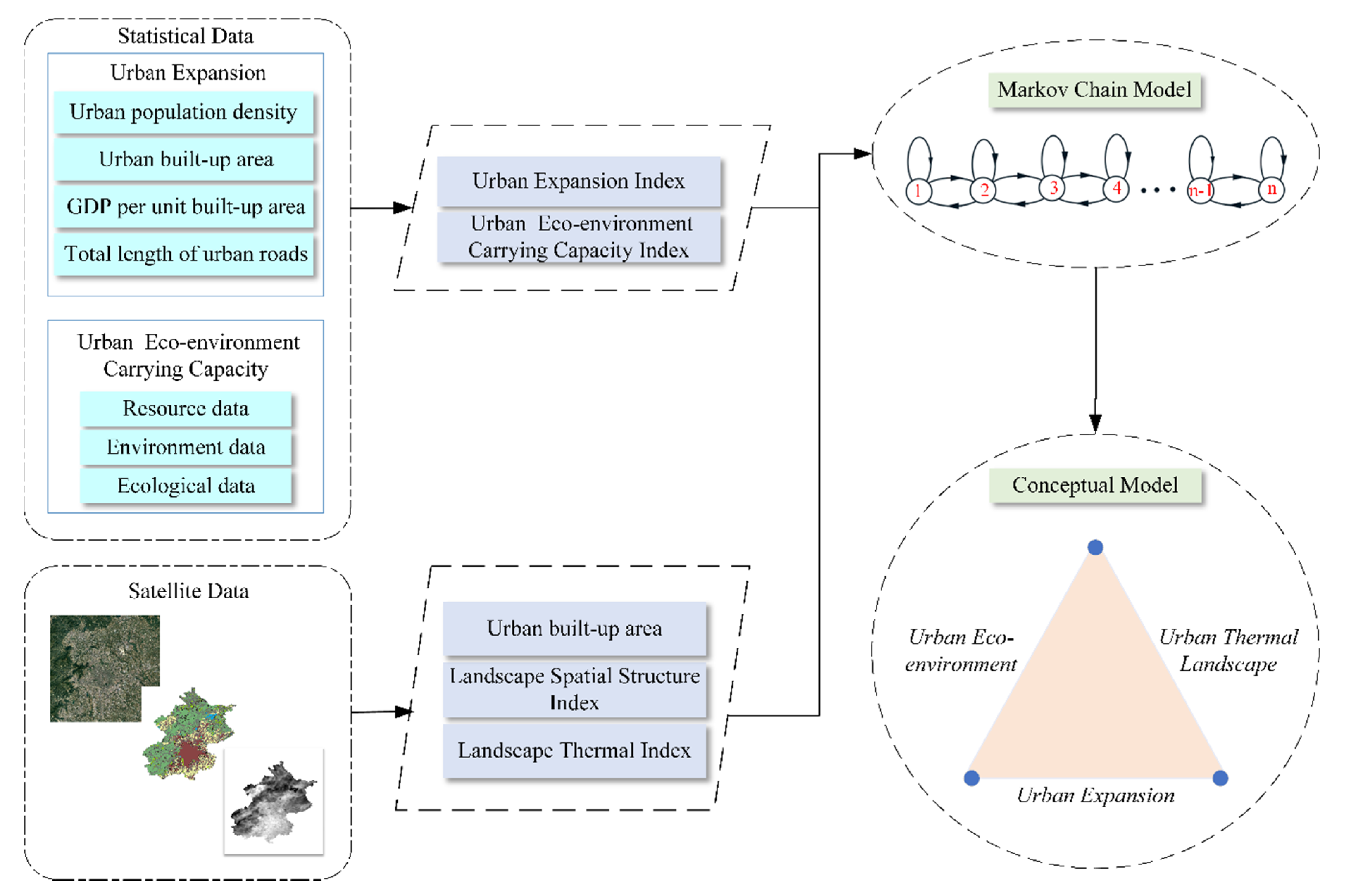
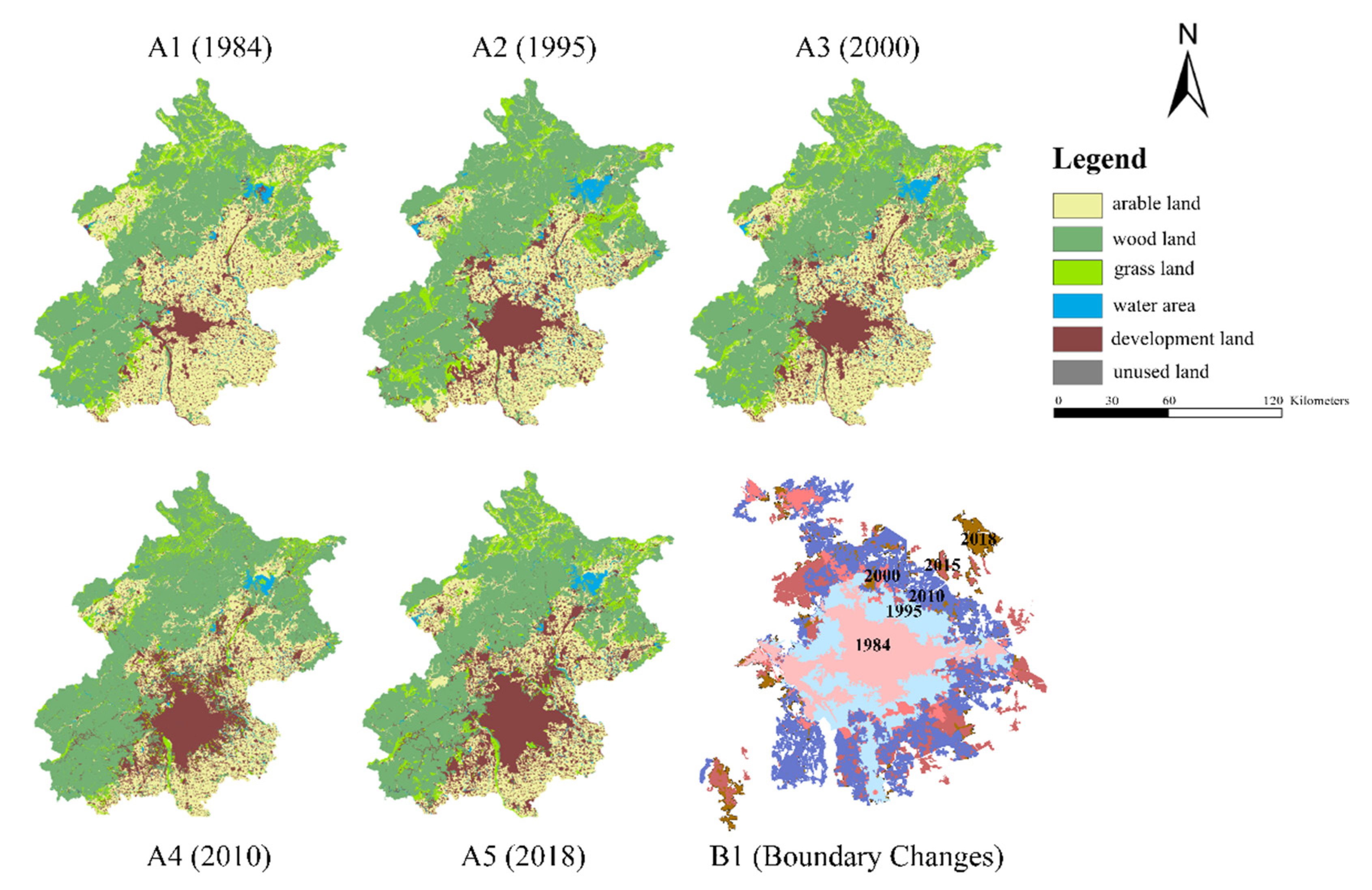
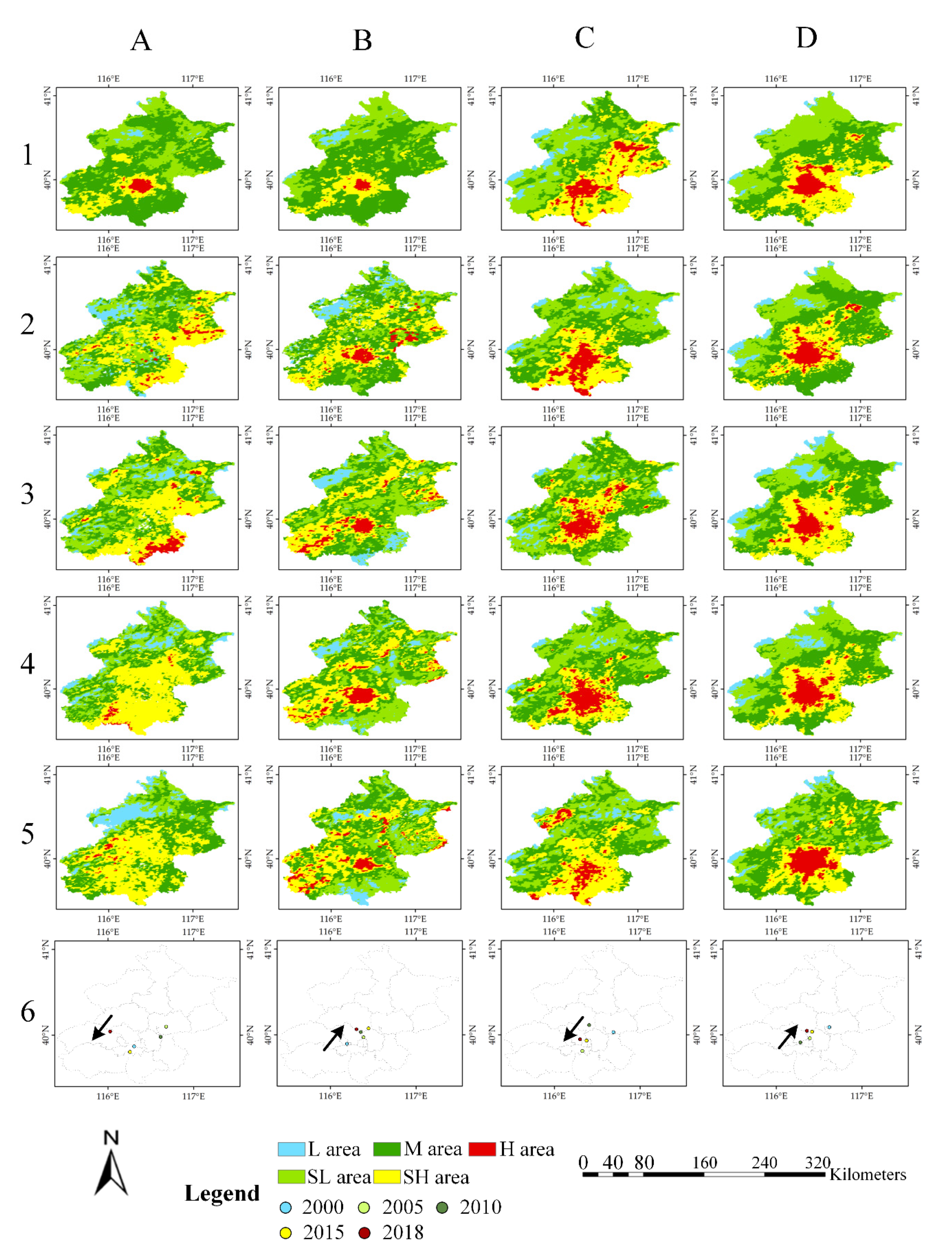

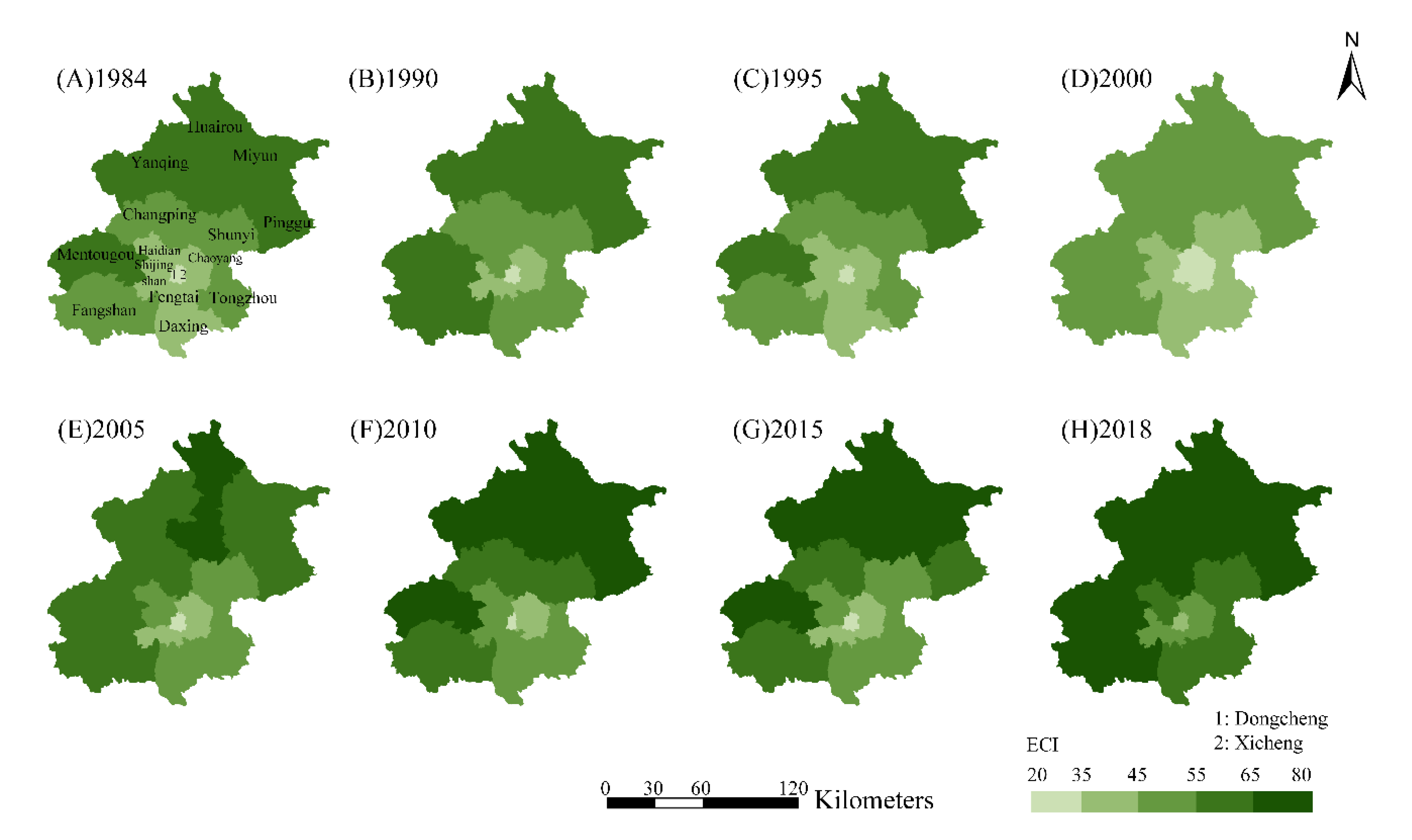
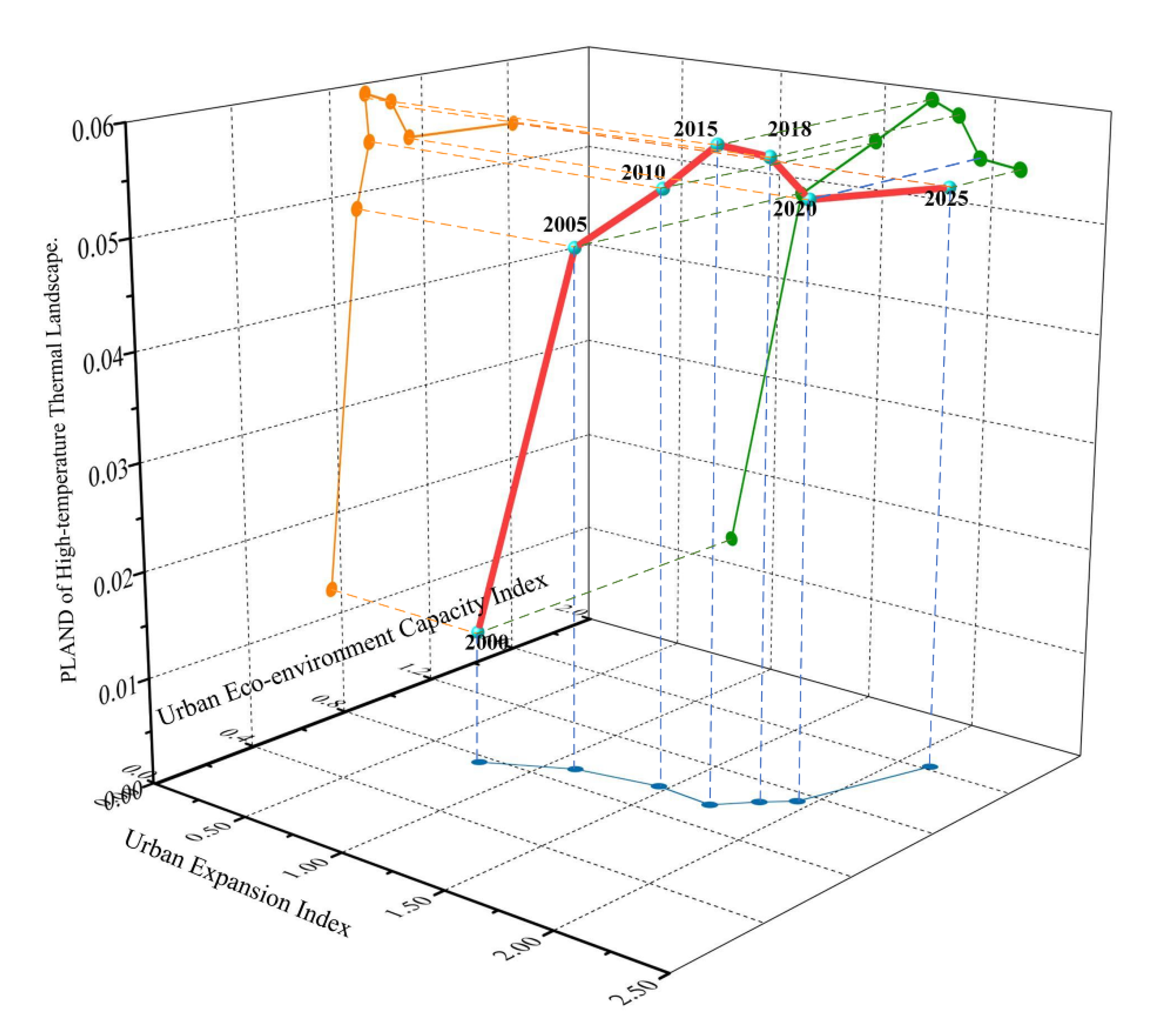
| Target Stratum | Factor Stratum | Index Stratum | Index Character |
|---|---|---|---|
| Population size | Urban population density | Positive | |
| Urban expansion indices | Geographical space | Urban built-up area | Positive |
| Economic capacity | GDP per unit built-up area | Positive | |
| Infrastructure | Total length of urban roads | Positive |
| Classification of Land Surface Temperature | Temperature Range |
|---|---|
| Low temperature | Ti < Ta − 1.5 S |
| Secondary low temperature | Ta − 1.5 S ≤ Ti < Ta − 0.5 S |
| Medium temperature | Ta − 0.5 S ≤ Ti < Ta + 0.5 S |
| Secondary high temperature | Ta + 0.5 S ≤ Ti < Ta + 1.5 S |
| High temperature | Ti ≥ Ta − 1.5 S |
| Target Stratum | Factor Stratum | First Grade Index Stratum | Second Grade Index Stratum | Index Character |
|---|---|---|---|---|
| Urban eco-environment capacity index | Resource capacity | Land Resources | Per capita available area | Positive |
| Population resources | Urban residents Urban planned population | Negative Positive | ||
| Energy | Energy production (tones of standard coal) | Positive | ||
| Water resources | Water availability Urban water consumption | Positive Negative | ||
| Biomass resources | Gross output value of agriculture Per capita expenditure for principal food | Positive Negative | ||
| Environment capacity | Atmospheric environment | Annual average daily inhalable motes Energy consumption | Negative Negative | |
| Water environment | Urban sewage treatment Proportion of high-quality water | Positive Positive | ||
| Ecological Capacity | Index of forest | Afforested area | Positive | |
| Index of green land | Urban green coverage rate Per Capita Public Green Areas | Positive Positive | ||
| Index of water body | Annual precipitation | Positive |
Publisher’s Note: MDPI stays neutral with regard to jurisdictional claims in published maps and institutional affiliations. |
© 2021 by the authors. Licensee MDPI, Basel, Switzerland. This article is an open access article distributed under the terms and conditions of the Creative Commons Attribution (CC BY) license (http://creativecommons.org/licenses/by/4.0/).
Share and Cite
Li, Y.; Ye, H.; Sun, X.; Zheng, J.; Meng, D. Coupling Analysis of the Thermal Landscape and Environmental Carrying Capacity of Urban Expansion in Beijing (China) over the Past 35 Years. Sustainability 2021, 13, 584. https://doi.org/10.3390/su13020584
Li Y, Ye H, Sun X, Zheng J, Meng D. Coupling Analysis of the Thermal Landscape and Environmental Carrying Capacity of Urban Expansion in Beijing (China) over the Past 35 Years. Sustainability. 2021; 13(2):584. https://doi.org/10.3390/su13020584
Chicago/Turabian StyleLi, Yu, Haipeng Ye, Xu Sun, Ji Zheng, and Dan Meng. 2021. "Coupling Analysis of the Thermal Landscape and Environmental Carrying Capacity of Urban Expansion in Beijing (China) over the Past 35 Years" Sustainability 13, no. 2: 584. https://doi.org/10.3390/su13020584
APA StyleLi, Y., Ye, H., Sun, X., Zheng, J., & Meng, D. (2021). Coupling Analysis of the Thermal Landscape and Environmental Carrying Capacity of Urban Expansion in Beijing (China) over the Past 35 Years. Sustainability, 13(2), 584. https://doi.org/10.3390/su13020584







